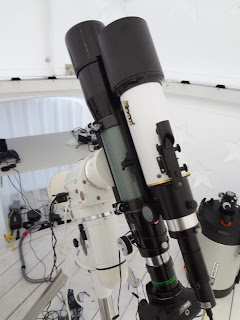This wasn't actually taken over a single month. Like I said weather tended to get in the way from one day to the next so it actually took me nearly a year to get all 5 images; if you've been reading my blog you've probably noticed one or two of them individually.
Interestingly enough many people are actually confused about why we see different phases of the moon. It definitely has to do with the moon orbiting around the Earth. But it has as much to do with the position of the sun as it does with the moon. Think of the moon like a giant mirror. The moon doesn't create its own light. Just like a mirror it reflects light. And where does that light come from? The sun! Now if the moon is on the opposite side of the Earth as the Sun all that light gets reflected towards the Earth. But if the moon and the sun are on the same side of the Earth NONE of the light bounces towards the Earth. In fact, if the moon and the sun align just right the moon can actually block the sun's light and we get an eclipse.
The image above shows the arrangement of the Earth, Moon and Sun (off to the right) that leads to the lunar phases.
A full orbit of the moon takes about 27.3 days (It actually takes the moon 29.5 days to reach the same position in the sky because while the moon is moving so it the earth. That's called the synodic period b). Its no coincidence that a lunar orbit corresponds to a full month. Early calendars were based on this lunar cycle.
Its also interesting to note that we don't see a solar eclipse once a month as you might expect. While the moon moves between the Earth and the Sun every 27.3 days it doesn't always line up with the sun. That's because the moon's orbit is inclined about five degrees with respect to the sun's orbit. That means that there are only a few times a year when a solar eclipse is possible. In order for an eclipse to actually occur at one of those times they must occur at the new moon (when the moon and the sun are on the same side as the Earth. The diagram below gives a good visual of this.
The only times a Solar Eclipse can happen is when the moons shadow falls on the Earth. As you can see from the diagram there are lots of times when the lunar shadow is above or below the Earth but only a few when it actually hits the Earth.
So the next time you look up and see the moon in sky try and figure out where it is in relation to the Earth and Sun!
Interestingly enough many people are actually confused about why we see different phases of the moon. It definitely has to do with the moon orbiting around the Earth. But it has as much to do with the position of the sun as it does with the moon. Think of the moon like a giant mirror. The moon doesn't create its own light. Just like a mirror it reflects light. And where does that light come from? The sun! Now if the moon is on the opposite side of the Earth as the Sun all that light gets reflected towards the Earth. But if the moon and the sun are on the same side of the Earth NONE of the light bounces towards the Earth. In fact, if the moon and the sun align just right the moon can actually block the sun's light and we get an eclipse.
The image above shows the arrangement of the Earth, Moon and Sun (off to the right) that leads to the lunar phases.
A full orbit of the moon takes about 27.3 days (It actually takes the moon 29.5 days to reach the same position in the sky because while the moon is moving so it the earth. That's called the synodic period b). Its no coincidence that a lunar orbit corresponds to a full month. Early calendars were based on this lunar cycle.
Its also interesting to note that we don't see a solar eclipse once a month as you might expect. While the moon moves between the Earth and the Sun every 27.3 days it doesn't always line up with the sun. That's because the moon's orbit is inclined about five degrees with respect to the sun's orbit. That means that there are only a few times a year when a solar eclipse is possible. In order for an eclipse to actually occur at one of those times they must occur at the new moon (when the moon and the sun are on the same side as the Earth. The diagram below gives a good visual of this.
The only times a Solar Eclipse can happen is when the moons shadow falls on the Earth. As you can see from the diagram there are lots of times when the lunar shadow is above or below the Earth but only a few when it actually hits the Earth.
So the next time you look up and see the moon in sky try and figure out where it is in relation to the Earth and Sun!
















